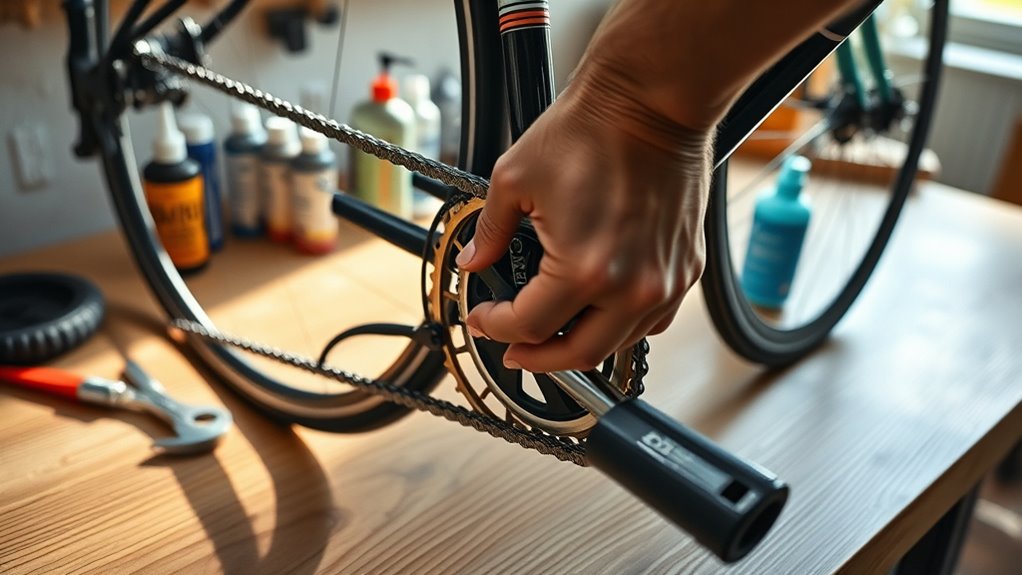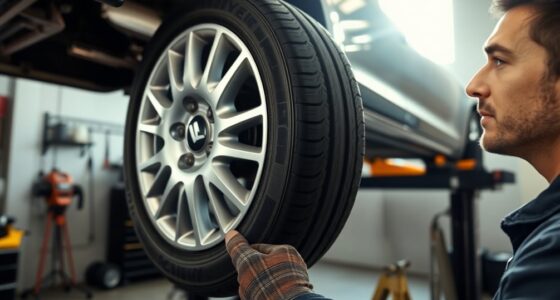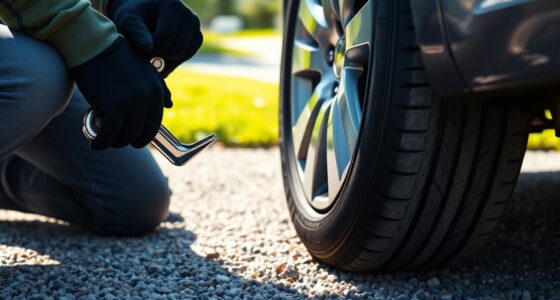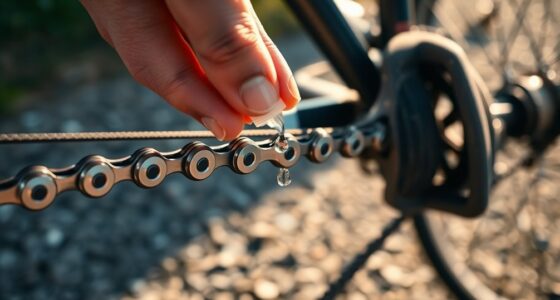Perform a DIY bicycle tune-up when your bike feels sluggish, noisy, or difficult to ride, or every few months to prevent issues. Start by inspecting the frame, tires, and wheels, then clean and lubricate the chain. Check and adjust brakes and gears, ensuring proper tension and alignment. Tighten any loose parts and inflate tires to the recommended pressure. Keep your bike in peak condition — uncover more tips to keep your ride smooth and safe.
Key Takeaways
- Perform a tune-up when your bike feels sluggish, gears slip, or unusual noises occur, or after rough rides for preventive maintenance.
- Gather essential tools like Allen wrenches, a bike pump, degreaser, lubricant, and cleaning rags before starting.
- Conduct a visual inspection of the frame, tires, wheels, and brakes to identify damage or wear.
- Clean and lubricate the chain, check brake pad wear, and adjust cables for smooth, responsive performance.
- Ensure tires are properly inflated, tighten all components, and test ride to confirm the bike is ready and safe to ride.

Ever wondered how to keep your bike running smoothly without spending a fortune at the shop? Performing a DIY bicycle tune-up is a practical way to maintain your ride and catch small issues before they become costly repairs. The key is knowing when to service your bike and how to do it properly, so you feel confident handling basic maintenance at home. Regular tune-ups not only extend the life of your bike but also improve its performance and safety, making every ride more enjoyable.
Perform DIY bike tune-ups to save money, boost performance, and keep your ride smooth and safe.
You should consider a tune-up whenever your bike feels sluggish, makes unusual noises, or if you notice difficulty shifting gears or braking effectively. Even if everything seems fine, doing a tune-up every few months or after a particularly rough ride helps keep components in top shape. The process isn’t complicated, but it requires some basic tools like a set of Allen wrenches, a bike pump, lubricant, and a clean rag. You don’t need to be a mechanic—just a willingness to learn and some time dedicated to caring for your bike.
Start with a visual inspection. Look over the frame for any cracks or damage, check the tires for wear or embedded debris, and ensure that the wheels spin freely without wobbling. Next, focus on the drivetrain: shift through all gears, and if any gear feels sticky or skips, it might need adjustment or cleaning. Clean the chain thoroughly with a degreaser and a brush, then dry it and apply fresh lubricant. This keeps the chain moving smoothly and prevents rust. Proper lubrication techniques are essential for maintaining optimal performance and avoiding premature wear. Regularly inspecting and maintaining your bike’s components helps prevent breakdowns and extends their lifespan. Incorporating routine component checks into your maintenance schedule can save you time and money in the long run. Remember, keeping the drivetrain clean and well-lubricated can also improve overall efficiency and reduce the effort needed to pedal.
Moving to the brakes, check the pads for wear and make sure they’re aligned properly with the rims or rotors. If the pads are worn down, replace them; if they’re misaligned, adjust their position. Squeeze the brake levers—if they feel soft or go to the handlebar, you might need to bleed the hydraulic brakes or adjust the cable tension. Adjusting the brake and shifter cables is straightforward: loosen the bolt, pull the cable taut, and retighten, ensuring smooth operation. Proper cable tension ensures responsive braking and shifting, contributing to a safer ride.
Finally, check the air pressure in your tires, inflating them to the recommended PSI printed on the sidewall. Properly inflated tires reduce rolling resistance and prevent flats. Airless paint sprayers are a good analogy for how maintaining your bike’s components ensures an even and reliable ride. Once everything feels tight, responsive, and clean, your bike is ready for your next ride. Performing this routine maintenance at home takes a little effort, but it’s rewarding to see your bike perform better and last longer. Plus, it gives you confidence in your ability to keep your bike in prime condition, saving you money and time spent at the shop.
Frequently Asked Questions
How Often Should I Perform a Full Bicycle Service?
You should perform a full bicycle service every 6 to 12 months, depending on how often you ride and riding conditions. Regular maintenance keeps your bike running smoothly and prevents costly repairs. You’ll want to check and lubricate the chain, inspect brakes, and verify gears shift properly. If you ride frequently or in harsh weather, consider servicing more often. Staying proactive keeps your bike safe and enjoyable to ride.
What Tools Are Essential for At-Home Bike Maintenance?
Tools for at-home bike maintenance make your mechanical moments manageable. You’ll need a reliable bike pump to perfect pressure, a set of screwdrivers for swift adjustments, and Allen wrenches for versatile tightening. Don’t forget a chain tool to tackle tangles, a tire lever to lift tires easily, and lubricants for lasting smoothness. With these essential tools, you’ll confidently tackle repairs, keep your bike in prime condition, and pedal happily on your own terms.
Can I Fix a Broken Derailleur Myself?
If your derailleur is broken, you can try fixing it yourself if you’re comfortable with bike maintenance. First, identify the issue—whether it’s misalignment, a bent hanger, or a damaged cable. You’ll need basic tools like a hex wrench and a replacement derailleur if necessary. Follow a step-by-step guide, and be patient. If you’re unsure, consulting a detailed tutorial or seeking professional help is always a smart move.
How Do I Identify Worn-Out Components Needing Replacement?
You’re looking to spot worn-out bike parts, like a detective searching for clues. Worn components often show signs of rust, cracks, or excessive play. Check your brake pads for thinning, and look for slack in your chain or gears. If shifting feels rough or the brakes squeal, those are signals you need replacements. Regular inspections keep your ride smooth, so stay attentive to these signs before small issues turn into big problems.
Is It Safe to Service My Bicycle Without Professional Help?
You might wonder if it’s safe to service your bike without a professional. If you have basic mechanical skills and the right tools, you can handle simple tasks like adjusting brakes, lubing chains, and changing tires. However, for complex issues like brake bleeding or gear tuning, it’s best to seek professional help to guarantee safety and proper function. Always know your limits to prevent accidents or damage.
Conclusion
By mastering these simple tune-up skills, you’re basically turning into a bicycle superhero—ready to conquer mountains, race against lightning, and outlast the universe itself! Regular maintenance keeps your ride smoother than a silk rollercoaster and faster than a cheetah on a jet-powered skateboard. So, grab your tools, release your inner mechanic, and show the road who’s boss. With a little effort, you’ll keep your bike humming like a well-oiled rocket blasting through the stars!









